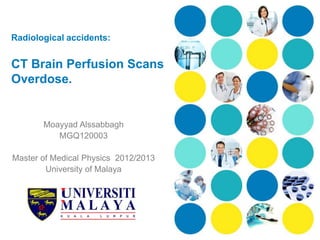
Radiation accident
- 1. Radiological accidents: CT Brain Perfusion Scans Overdose. Moayyad Alssabbagh MGQ120003 Master of Medical Physics 2012/2013 University of Malaya
- 2. Radiological accidents: CT Brain Perfusion Scans Overdose In this Presentation: • What is CT perfusion scan • Accident description • Accident causes • The consequences, impact and implications • Lessons learned and recommendations
- 3. Radiological accidents: CT Brain Perfusion Scans Overdose • What is CT Perfusion scan: It’s a kind of diagnostic x-ray scans produce cross-sectional images or 'slices' of specific areas of the head.
- 4. Radiological accidents: CT Brain Perfusion Scans Overdose • Why: For stroke test which is the evaluation of blood flow in the brain. • Causes: It happens when blood flow to a part of the brain stops, which lead to brain cells die or causing permanent damage due to lack of blood and oxygen. • A stroke is called also a "brain attack.“
- 5. Radiological accidents: CT Brain Perfusion Scans Overdose Accident description • In Oct. 2009, the first notification was reported (FDA) • Patients undergoing computed tomography (CT) brain perfusion scans were accidently exposed to excess radiation doses.
- 6. Radiological accidents: CT Brain Perfusion Scans Overdose Accident disc. - Cont. • Some patients reported obvious signs of excessive radiation exposure following their scans, such as hair loss or skin redness, which called attention to the problem.
- 7. Radiological accidents: CT Brain Perfusion Scans Overdose Problem Description – cont. • Over 385 patients from six hospitals all in California alone, were exposed to excess radiation during CT brain perfusion scans • Other cases appeared: – More than 200 patients in a hospital in Los Angeles – And dozens more at a hospital in Huntsville, Alabama, were being overdoses too.
- 8. Radiological accidents: CT Brain Perfusion Scans Overdose How much radiation dose they received? • Instead of receiving the expected dose of 0.5 Gy to the head (depend on patient size, age, condition and scanner design, etc.), these patients received 3-4 Gy (approximately eight times) which is in some cases resulted in hair loss and erythema.
- 9. Radiological accidents: CT Brain Perfusion Scans Overdose • How did this happen? (Accident causes) • An investigation by the Food and Drug Administration (FDA) was set • Technicians intentionally used high levels of radiation to get clearer images. (Recommendation by the companies that supplied the scanners) • No manufacturer-defined protocol provided to get reasonable and appropriate image quality and dose. • Hospitals modified their own scanning protocols .
- 10. Radiological accidents: CT Brain Perfusion Scans Overdose The consequences, impact and implications • In Addition to hair loss and skin redness, patients experienced headaches, memory loss and confusion. • Over time, excessive radiation exposure can place patients at increased risk for long-term radiation effects, such as risk of brain damage and cancer.
- 11. Radiological accidents: CT Brain Perfusion Scans Overdose • It also has social effects, which may be reflected on the psychological state of the patient, which can also lead to work loss. Mr. Alain Reyes’s co-workers at a shipping company avoided him, and his boss sent him home, fearing he had a contagious disease.
- 12. Radiological accidents: CT Brain Perfusion Scans Overdose Lessons learned and recommendations • The problem may not be detected because the dose is not high enough to cause radiation injury. • Regulatory agencies was unaware of those doses but started to investigate after a news paper brought them to the public attention. • Providing particular information, protocols and training on brain- perfusion to all facilities that receiving CT equipments. A medically-needed CT scan that does not expose the patient to unnecessary radiation has benefits that far outweigh the radiation risks
- 13. Radiological accidents: CT Brain Perfusion Scans Overdose
- 14. Radiological accidents: CT Brain Perfusion Scans Overdose • References • U.S. Food and Drug Administration http://www.fda.gov/MedicalDevices/Safety/AlertsandNotices/ucm193293 .htm http://www.fda.gov/MedicalDevices/Safety/AlertsandNotices/ucm185898 .htm • The New York Times news paper. The New York Times Company (NYSE: NYT)
